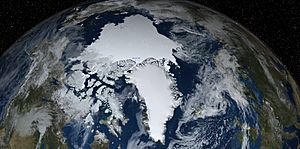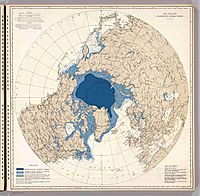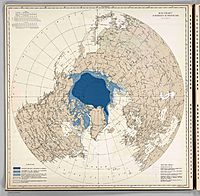Arctic ice pack facts for kids

The Arctic ice pack is a huge sheet of ice that covers the Arctic Ocean. It changes throughout the year. In spring and summer, some of the ice melts. Then, in autumn and winter, it grows bigger again. The smallest amount of ice is usually seen around mid-September.
The ice that stays frozen for more than one year is called multi-year ice. This ice is much thicker than ice that forms and melts in one year. Multi-year ice can be about 3 to 4 meters (10 to 13 feet) thick. Some parts, called ridges, can be as thick as 20 meters (66 feet)! Sadly, over the past few decades, the amount of sea ice in the Arctic has been shrinking.
Contents
Why Arctic Ice is Important
How Ice Affects Earth's Heat
Sea ice plays a big role in how warm or cold the polar oceans are. It acts like a blanket, keeping the warmer ocean water from losing too much heat to the very cold air above.
Ice is also very shiny! It reflects a lot of the sun's energy back into space. Bare ice reflects about 60% of sunlight, and if it's covered in snow, it reflects about 80%. This is called the albedo effect. The open ocean, however, only reflects about 10% of sunlight. So, when there's less ice, the ocean absorbs more heat, which can make it even warmer.
How Ice Affects Ocean Water
The way sea ice forms and melts also creates special "bottom water" in the ocean. When seawater freezes, it pushes out most of its salt. This makes the water left behind extra salty and very dense (heavy). This dense water then sinks to the bottom of the ocean.
This sinking of dense water helps keep important ocean currents moving, like the North Atlantic Deep Water current. These currents are like giant conveyor belts that move heat around the planet. Understanding this process is key for scientists who study Earth's climate.
The Odden Ice Tongue
The Odden ice tongue is a unique area in the Greenland Sea. "Odden" means "headland" in Norwegian. Here, a type of ice called "pancake ice" is very common. In winter, this ice tongue grows eastward.
Very cold water from the Jan Mayen Current helps new ice form here. Even though some old ice drifts away, the cold water exposed to the rough seas quickly forms new ice, often in small, round shapes like pancakes.
Changes in Arctic Sea Ice
Scientists have been tracking Arctic sea ice for a long time. Good records from satellites started in the late 1970s. These satellites can measure the ice even when it's dark or cloudy. They measure both the total area of the ice and its "extent." The extent is a bit larger because it includes any ocean area that has at least 15% ice.
Studies show that the amount of Arctic ice has been decreasing. From 1947 to 1999, the ice volume (how much ice there is) went down by 3% every ten years. This was due to rising temperatures.
More recent data from 1979 to 2002 showed a decrease of about 2.5% per decade. Climate models predicted this trend. The amount of ice in September (when it's at its lowest) has dropped even faster. From 1979 to 2011, it went down by 12% every ten years.
In 2007, the ice reached a new low, shrinking by more than a million square kilometers (about 386,000 square miles). This was the biggest drop since satellites started tracking the ice. In 2012, it hit an even lower record, reaching about 3.5 million square kilometers (1.35 million square miles).
Scientists are finding that the Arctic sea ice is melting faster than many computer models had predicted. The total amount of ice depends on both how much area it covers and how thick it is. Measuring thickness is harder, but scientists know that a lot of the ice now is thinner, first-year ice. This thinner ice is more easily broken up by storms.
Images for kids
See also
 In Spanish: Casquete polar ártico para niños
In Spanish: Casquete polar ártico para niños










